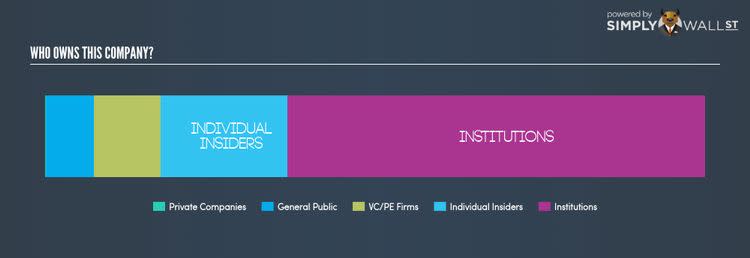Who Owns AFC Energy PLC (AIM:AFC)?

In this article, I’m going to take a look at AFC Energy PLC’s (AIM:AFC) latest ownership structure, a non-fundamental factor which is important, but remains a less discussed subject among investors. Ownership structure of a company has been found to affect share performance over time. Since the same amount of capital coming from an activist institution and a passive mutual fund has different implications on corporate governance, it is a useful exercise to deconstruct XYZ’s shareholder registry. All data provided is as of the most recent financial year end.
See our latest analysis for AFC
Institutional Ownership
Institutions account for 63.23% of AFC’s outstanding shares, a significant enough holding to move stock prices if they start buying and selling in large quantities, especially when there are relatively small amounts of shares available on the market to trade. However, as not all institutions are alike, such high volatility events, especially in the short-term, have been more frequently linked to active market participants like hedge funds. In the case of AFC, investors need not worry about such volatility considering active hedge funds don’t have a significant stake. However, we should dig deeper into AFC’s ownership structure and find out how other key ownership classes can affect its investment profile.
Insider Ownership
I find insiders are another important group of stakeholders, who are directly involved in making key decisions related to the use of capital. In essence, insider ownership is more about the alignment of shareholders’ interests with the management. AFC insiders hold a significant stake of 19.11% in the company. This level of insider ownership has been found to have a negative impact on companies with consistently low PE ratios (underperformers), while it has been positive in the case of high PE ratio firms (outperformers). It may be interesting to take a look at what company insiders have been doing with their holdings lately. Insider buying may be a sign of upbeat future expectations, however, selling doesn’t necessarily mean the opposite as insiders may be motivated by their personal financial needs.
General Public Ownership
With 7.36% ownership, the general public are also an important ownership class in AFC. This size of ownership, while considerably large for a public company, may not be enough to change company policy if the decision is not in sync with other large shareholders.
Private Equity Ownership
With an ownership of 10.12%, private equity firms are a major stakeholder in AFC and are in a position to play an important role in shaping up corporate strategy with a focus on value creation. This is an encouraging sign for investors as these investors tend to be active strategist in companies, focusing on increasing operational and capital efficiency for the firm.
Private Company Ownership
Another group of owners that a potential investor in AFC should consider are private companies, with a stake of 0.18%. While they invest more often due to strategic interests, an investment can also be driven by capital gains through share price appreciation. However, an ownership of this size may be relatively insignificant, meaning that these shareholders may not have the potential to influence AFC’s business strategy. Thus, investors not need worry too much about the consequences of these holdings.
What this means for you:
Are you a shareholder? The company’s high institutional ownership makes margin of safety a very important consideration to existing investors since long bull and bear trends often emerge when these big-ticket investors see a change in long-term potential of the company. This will allow investors to reduce the impact of non-fundamental factors, such as volatile block trading impact on their portfolio value. If you’re interested in bolstering your portfolio with new stocks and are looking for ideas, take a look at our free app to see my list of stocks with a strong growth potential.
Are you a potential investor? Ownership structure should not be the only determining factor when you’re building an investment thesis for AFC. Rather, you should be examining fundamental factors like the intrinsic valuation of AFC, which is a key driver of AFC’s share price. Take a look at our most recent infographic report on AFC for a more in-depth analysis of these factors to help you make a more well-informed investment decision.
NB: Figures in this article are calculated using data from the last twelve months, which refer to the 12-month period ending on the last date of the month the financial statement is dated. This may not be consistent with full year annual report figures.
To help readers see pass the short term volatility of the financial market, we aim to bring you a long-term focused research analysis purely driven by fundamental data. Note that our analysis does not factor in the latest price sensitive company announcements.
The author is an independent contributor and at the time of publication had no position in the stocks mentioned.

